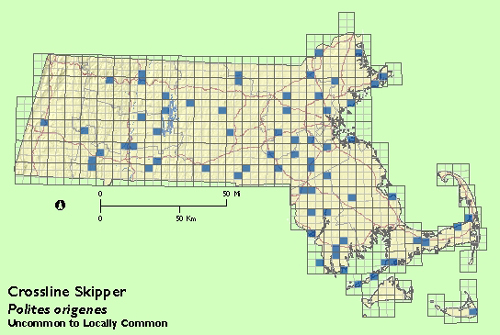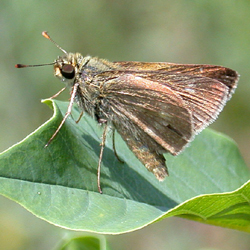Butterfly Atlas
Find a Butterfly
Crossline Skipper
Polites origenes
Named
Fabricius, 1793

Identification
Wingspan: 1 and 3/16 to 1 and 1/2." Similar to Tawnet-edged Skipper (P. themistocles), which see for detailed distinctions.
Distribution
Extreme southern Saskatchewan, western Dakotas and eastern Rockies east through the southern Great Lakes Region to central Maine; northeastern Texas east to northern Florida and throughout the mid-Atlantic States. North throughout New England to central Maine.
Status in Massachusetts
Uncommon to locally common. Though widespread across the state with records from the westernmost border to Cape Cod and Islands, this species is less common than the Tawny-edged Skipper. Maximum: 5 on 3 July 1990, Westport (Bristol Co.).

Flight Period in Massachusetts
One flight: from late June to early August. Extreme dates: 29 June 1986, Petersham (Worcester Co.), J. Baird and 10 August 1986, Sharon (Norfolk Co.), B. Cassie.
Larval Food Plants
Grasses including Little Bluestem (Schizachyrium [Andropogon] scoparius ) and Purpletop (Tridens flavius)
Adult Food sources
Found nectaring on 15 species of flowering plants by atlas workers including Common Milkweed and Cow Vetch.

Habitat
Old fields, power lines, sand barrens, and other open, relatively dry situations.
Life Cycle
EGG: Pale green; dome-shaped. OVIPOSITION: Eggs are laid on hostplant grasses and hatch in approximately two weeks.
LARVA: Dark brown and mottled with white; the head is black. CHRYSALIS: Bluish-gray with a darker head. OVERWINTERING STAGE: Third or fourth instar larva.
Like the Tawny-edged, male Crosslines often perch in open situations awaiting receptive females. Caterpillars make a shelter by silking together the edges of a blade of grass.
This account was contributed by Richard K. Walton and Christopher Leahy.
Account Author
Richard K. Walton



